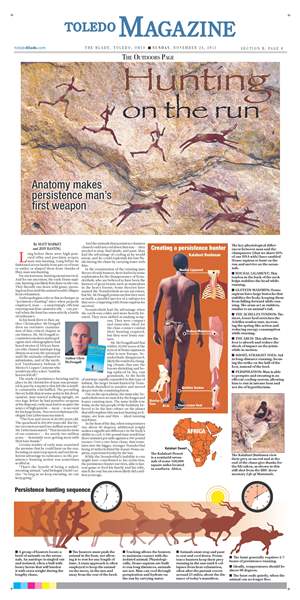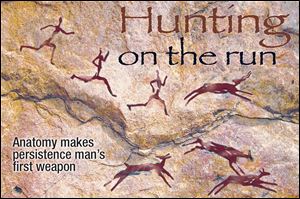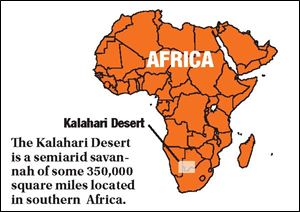
TOLEDO MAGAZINE: OUTDOORS
Hunting on the run
Anatomy makes persistence man's first weapon
11/24/2013

Long before there were high-powered rifles and precision scopes, man was hunting. Long before he fashioned arrow heads from pieces of bone or antler, or shaped them from chunks of flint, man was hunting.
For ancient man, hunting meant survival. And for our ancestors, the early Homo sapiens, hunting was likely first done on the run. They literally ran down wild game, pursuing it on foot until the animal would collapse from exhaustion.
Anthropologists refer to this technique as “persistence hunting” since when properly employed, man — a surprisingly efficient running machine anatomically — can prevail when the hunt becomes strictly a battle of endurance.
DOWNLOAD OR VIEW THE FULL MAGAZINE PAGE

In his book Born to Run, author Christopher McDougall does an extensive examination of this critical chapter in our history. Mr. McDougall recounts how modern anthropologists and ethnographers had heard stories of African hunters who chased antelope long distances across the savanna until the animals collapsed in submission, and of the mythical Tarahumara Indians of Mexico’s Copper Canyons who would run after a deer “until its hooves fell off.”
The study of persistence hunting and its place in the chronicles of man was prompted in part by a mystery that left the scientific community a bit baffled. The prevailing theory holds that at some point in his development, man started walking upright, on two legs. Before he had primitive weapons at his disposal, early man had to acquire his source of high protein — meat — to account for his large brain, Harvard evolutionary biologist Dan Lieberman surmised.
“The bow and arrow is 20,000 years old. The spearhead is 200,000 years old. But Homo erectus is around two million years old,” Mr. Lieberman stated. “That means for most of our existence — for nearly two million years — hominids were getting meat with their bare hands.”
Certain studies of early man examined the premise that he could hunt on the run, focusing on man’s top speed, and not his inherent advantage in endurance, so the persistence hunting notion was sometimes scoffed at.
“That’s the benefit of being a naked, sweating animal,” said biologist David Carrier. “As long as we keep sweating, we can keep going.”
And the animals that persistence hunters chased could not cool down that way — they needed to stop, find shade, and pant. Man had the advantage of cooling as he would sweat, and he could replenish his lost fluids during the chase by carrying water with him.

In the examination of the running man theory of early hunters, there had to be some explanation for the disappearance of Neanderthals, who are believed to have been the hunters of great beasts such as mastodons in the heavy forests. Some theories have named the Neanderthals as our ancestors, but Mr. McDougall points out that they were actually a parallel species of a sub-species that were competing with Homo sapiens for survival.
Neanderthals had the advantage when the earth was colder and more heavily forested. They were skilled at making weapons. They were compact and muscular, ideal for the close-contact combat their hunting required, but they were lousy runners.
Mr. McDougall said that within 10,000 years of the arrival of Homo sapiens in what is now Europe, Neanderthals disappeared, likely the result of a changing climate that saw the forests shrinking and being replaced by dry, vast grasslands. As the herds of antelope rapidly expanded in this type of habitat, the larger beasts hunted by Neanderthals dwindled in number and moved deeper into the remaining forest.
Out on the open plains, the muscular Neanderthals were no match for the longer and leaner running men. The same holds true today, as the San people of the Kalahari, believed to be the last culture on the planet that still employs this ancient hunting technique, are lean and thin — ideal running machines.

In the heat of the day, when temperatures rise above 90 degrees, additional weight makes a significant difference in the body’s ability to cool. A 160-pound man would lose three minutes per mile against a 100-pound runner. Over a two-hour chase, that translates into the bigger, stronger Neanderthal being 10 miles behind the leaner Homo sapiens, represented today by the San.
While the Neanderthal’s inability to run might have contributed to his extinction, the persistence hunter survives, able to harvest game to feed his family and his tribe, much the way his ancestors likely did a million years ago.